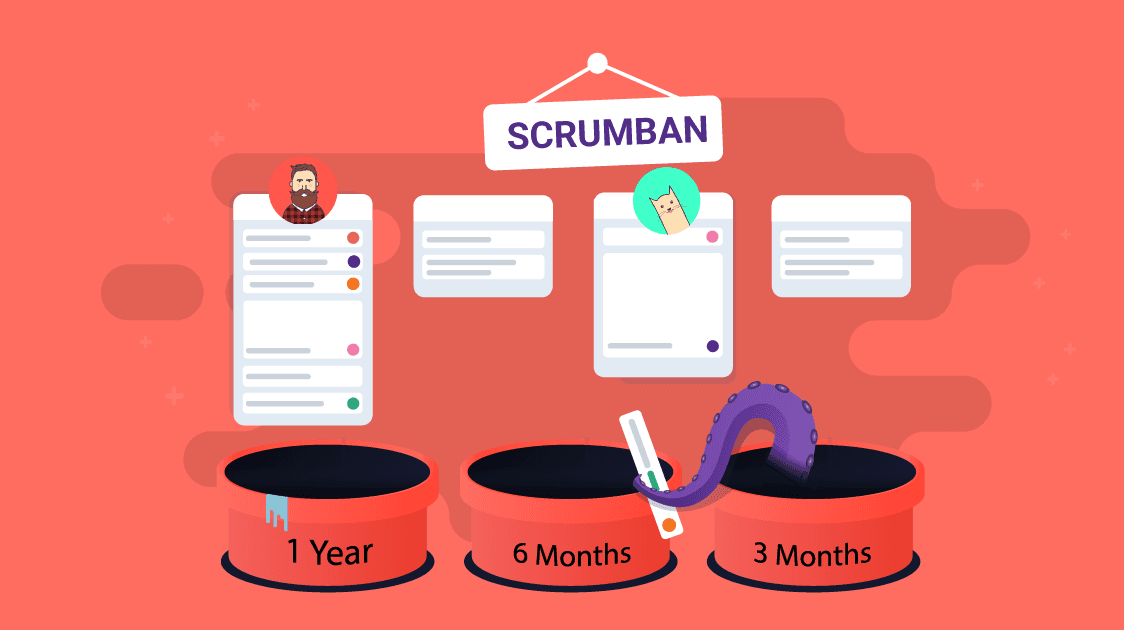You know Scrum… You know Kanban... and now you’re probably wondering what the heck exactly is Scrumban?
That's exactly the topic of this article and by the end of it, you’ll be familiar with Scrumban and ready to practice it with your software development team.
So here’s what you’ll learn:
- What is Scrumban?
- How does Scrumban work? (Theory)
- Scrumban: Pros & Cons
- Scrumban In Agile Software Development In 2022 (Practice)
- Scrumban in a Nutshell with practical suggestions
Don’t worry if you’re not familiar with Scrum or Kanban! Our goal today is to teach you the Scrumban methodology without using fancy words so you can know everything you need to know to implement it in practice the right way.
That being said, we’re ready to answer directly the big project management question in 2022 - What exactly is Scrumban?
1. What is Scrumban?

Scrumban is an Agile project management methodology that is a hybrid of Scrum and Kanban. The name Scrumban comes as a combination of [Scrum + (Kan)ban]. Scrumban was developed to make it easier for existing Scrum teams to transition to Kanban and explore lean methodologies.
Scrumban combines the structure of Scrum with the flow-based methods and visualization of Kanban. It allows teams to have the agility of Scrum and the simplicity of Kanban while requiring no role updates and being easy to adopt.
2. How does Scrumban work?
The work in Scrumban is organized in small chunks - Iterations (imagine them as mini Scrum sprints) that are visualized on a Scrumban board (a Kanban board on steroids). To get the work started and going On-Demand Planning meetings are held when there is a need to determine what User Stories and Tasks to be completed in the next Iteration.
Iteration
Work iterations in Scrumban are similar to the sprints in Scrum and have the goal to deliver something shippable after their completion. The two main differences are that:
- Scrumban iterations are shorter than the Scrum sprints
- Tasks in the iterations have no assignees (the team members choose their tasks themselves)
To keep Iterations short To-Do limit is set that limits the maximum number of tasks in the To-Do column.
Iteration’s length in Scrumban is measured in weeks and the ideal length of an iteration depends on the specifics of the work process and the industry.
Suggestion: As a rule of thumb, it’s recommended not to have iterations exceeding two weeks.
On-Demand Planning
The planning in Scrumban isn’t weekly or monthly but rather based on demand. It occurs only when the Planning trigger goes off
The Planning trigger is associated with the number of tasks left in the "To-Do" column of the Scrumban board. When it goes below a certain threshold (number) the planning event is held.
The goal of the On-Demand Planning event is to pick tasks only from the 3-month bucket, if necessary define new tasks on-the-go and add them to the “To-Do” section of the Scrumban board.
Suggestion: It’s recommended to prioritize tasks during the planning event. Prioritization can be done by adding numbers to the tasks or by ordering tasks by priority in the To-Do column, where the most important tasks are put at the top and the less important tasks below
The 3 Buckets Planning (Long-term Prioritization)

Bucket size planning in Scrumban brings the possibility of long-term planning. It's based on the system of three buckets that the work items need to go through before making it to the Scrumban board. The three buckets represent the three different stages of the plan and are usually called 1-year bucket, 6-month bucket, and 3-month bucket.
The 1-year bucket (Ideas)
It’s a bucket is dedicated to the long-term goals and ideas the company has - like penetrating a new market, releasing a new product, re-inventing existing product, etc.
The 6-month bucket (Requirements)
When the company decides to move forward with a plan or an idea from the 1-year bucket, it’s moved to the 6-month bucket, where the main requirements are crystallized and defined.
The 3-month bucket (Tasks)
When the company is ready to start implementing a plan from the 6-month bucket, it’s moved into the 3-month bucket and divided into clear tasks that can be implemented by the development team.
The Scrumban Board
🕹 Interactive example of a ScrumBan project in Ora
The Scrumban board looks like a Kanban board and it usually has three core columns: To-Do, Doing and Done. On the On-Demand planning, the tasks are added to the To-Do column when a team member starts working on a task, he/she moves it to the Doing column and when he/she completes the task, he/she moves it to the Done column.
The Doing column can be expanded in additional workflow columns specific to the business. For example Designing, Developing, Reviewing and Testing.
⚠️ To be able to execute the On-Demand planning events and prioritization efficiently it's mandatory to have the 3 Buckets planning system integrated into your project management software and linked to your Scrumban board.
Suggestion: A good Scrumban board should also support setting:
- Planning Trigger - counter of the tasks in the To-Do column that triggers the On-Demand planning event
- To-Do limit - limits the maximum number of tasks in the To-Do column
- Work-In-Progress limit - counter that limits the maximum tasks in progress
- Estimations - estimating the effort each task requires and the opportunity to track the time spent on it
The Team
Scrumban doesn't require any specific number of team members or dedicated team roles. For example, there’s no need for “Scrum Master”, “Product Owner” or any other kind of titles like in Scrum. The team roles stay the same as before adopting Scrumban and all team members have equal rights.
Also, the tasks are not assigned by someone but rather the team members choose which tasks to complete from the Scrumban board themselves.
3. Scrumban: Pros & Cons
Advantages (Pros)
✅ Saving time
In Scrumban there is no need to do estimation and sprint planning every second week. The team plans only when there's a demand for it - the number of To-Do tasks falls below a predefined threshold. This saves a lot of time spent in recurring planning meetings.
✅ Scrumban helps you handle large projects
Large projects consist of multiple features and tasks which must be delivered in the course of months or years. In Scrumban, they can be all distributed in the 1-year, 6-month, and 3-month buckets and prioritized in short 1-2 weeks iterations.
✅ Scrumban reveals bottlenecks in your workflow
Like in Kanban, you’ll have your whole workflow visible on a Scrumban board. This way you can see in which column there are the most tasks hence which stage slows the whole delivery process.
✅ Everyone is on the same page
Since Scrumban takes the visualization advantage from Kanban. Every team member can have a look and update the status of every project or task. This way all tasks are visible which brings transparency to the whole work process.
✅ Easy to adopt and simple process
Scrumban requires no role changes and dedicated “Scrum Master” or “Product Owner”. It’s easy to understand methodology which is visually represented and consists only of one planning meeting and straightforward rules.
✅ Scrumban brings equality and less stress in the team
Team members in Scrumban choose their tasks themselves. Tasks aren't assigned by a project manager and every team member selects which task from the To-Do column to complete next. And since everyone has equal rights, full visibility of the project, and no mandatory daily stand-ups there's less stress and frustration.
Disadvantages (Cons)
⚠️ Can turn into a methodology mish-mash
Scrumban is a fairly new agile project management methodology that is a hybrid of Scrum and Kanban. So there aren’t clearly defined best practices, yet. And since the basic principles of Scrumban are permitting, some teams may decide to invent on their own.
⚠️ Hard to track individual team member's effort and contribution
Every team-member in Scrumban chooses their tasks themselves and there aren't mandatory daily stand-up meetings which make the tracking of what everyone did, is doing and plan to do next harder.
⚠️ Less control for the project manager
Since there's equality in the team, no mandatory daily-standups and everyone can assign tasks, the project manager’s control is limited. He can decide what to pick from the 3-month bucket, which tasks to schedule on the On-Demand Planning and how to prioritize them. From there the team members decide on their own how to handle and implement them.
4. Scrumban In Agile Software Development In 2022

Let's get practical! If you’ve considered adopting Scrumban in your software development team or startup there are 3 primary things that you should focus on:
- To get work done faster and more efficiently
- To identify bottlenecks and eliminate them
- To work optimally without frustration and hence have a happy & motivated team of developers
In this section, we’ll cover the 3 Principles of Scrumban that'll help you achieve top-notch productivity and never miss a deadline in the dynamic software development environment.
1) The Pull Principle
As we already mentioned, in Scrumban tasks aren't assigned to the team members by a team leader or a project manager. Each team member chooses alone which task from the To-Do section to work on and complete next. He starts implementing them by using the Pull Principle and moving them to the appropriate “In-Progress” column of the Scrumban board.
⚠️Warning: Be extra careful with disloyal employees who take the way of the least resistance and pick only the easiest tasks because it can frustrate the other loyal team members!
2) Feature Freeze
Feature freeze in Scrumban is used when the project deadline is approaching. It states that only the features that the team has already scheduled for development can still be worked on and no other additional features can be added to the To-Do column.
Practical Tip: When you see that your deadline is approaching… Just STOP and don't try to overdeliver. Don't add more new features or tasks at the last moment and focus only on finishing what’s already in progress.
3) Triage
Triage usually happens right after Feature Freeze with an approaching project deadline. The project manager decides which of the in-development features will be completed and which will stay unfinished.
Or simply put, finish only what's mandatory and can be finished in time.
Suggestion: In reality not always you can finish and deliver everything you planned to. So when Triage happens focus only on the must-haves and drop everything else which is nice-to-have.
⚠️ Warning: From my developer experience, usually when Triage happens the refactoring and code-base improvements are neglected. And again from experience that’s a big NO-NO because it leads to bugs in production, harder project maintenance and more missed deadlines in the future!
5. Scrumban In A Nutshell: Final Thoughts and Suggestions
Scrumban is a hybrid version of Scrum and Kanban. It combines the benefits of both methodologies by using the visualization of Kanban and the systematization of Scrum while not introducing extra complexity and being easy to adopt. Scrumban is flexible in production and works well in large projects.
However, it can reduce the control the project manager has compared to Scrum and as in Kanban, it’s hard to track individual team member effort. Also, an outdated Scrumban board can cause trouble. So keep your Scrumban board up-to-date and stay connected with your team to Scrumban your productivity to the next level!
Conclusion: Scrumban is a good fit for startups, fast-paced software projects, continuous product development, and loyal teams which would sacrifice strict rules and hierarchy for extra time, more efficiency and freedom.
Final Thoughts
If you’re still hesitating which project management methodology would best fit your software development team take a look at our complete guide on Kanban vs Scrum vs Scrumban: What Are The Differences? [2022].
Or if you prefer the easy way, take this 3-minute quiz to find which project management methodology would best fit your needs. No registration needed, no email required & completely anonymous!
Before we wrap-up this up you might be also thinking which project management software in 2022 is best for Scrumban project management...
Well, if this article and Scrumban resonate with you, you might want to check our Scrumban project management software for startups and development teams👇
Ora - Scrumban Project Management Software: designed for software development teams and startups

Ora is project management software designed for software developers, product teams, and startups.
What makes Ora unique is the fact that Ora uses the Scrumban project management methodology since it’s beginning and have integrated all the features required for achieving top productivity in the dynamic development world on practice.
Knowing one thing in theory is one thing, but actually practicing it is a whole different thing.~ a Wise man
The same applies to Scrumban so instead of just reading theory... Why don’t you try Scrumban for yourself by signup to Ora for free and applying the knowledge from this post directly on your Scrumban board?
Try Ora today to shatter your productivity limits tomorrow!
* no credit card required
* free forever for up to 10 members
Ora’s Scrumban Core Features
Scrumban board integrated with 3 Buckets planning system
Custom Actionable Workflows Support


Time-Tracking & Estimations
Ora is designed for developers by developers
Code in task descriptions

Advanced Git Integration

Save time from searching commits by directly seeing them and their diffs in your project management software! Cool, isn’t it?
BONUS: Connect with Slack

Always know what’s happening with your project and who, on what, and how much is working by receiving updates and reports directly to your Slack channels!

Or if you want to know more about Ora first check our features for more information.
Thanks for reading so far! I hope you’ve learned something new enjoy this article on Scrumban project management for software and development teams :)
Cheers,
Iliyan



